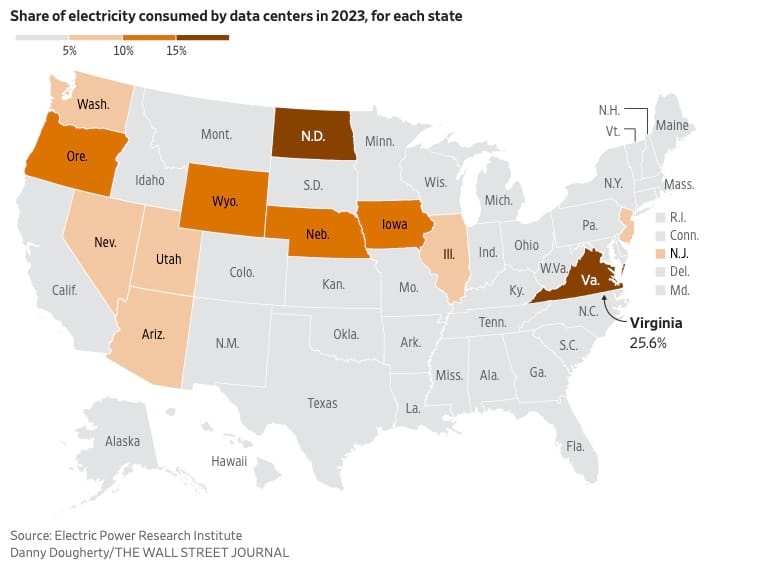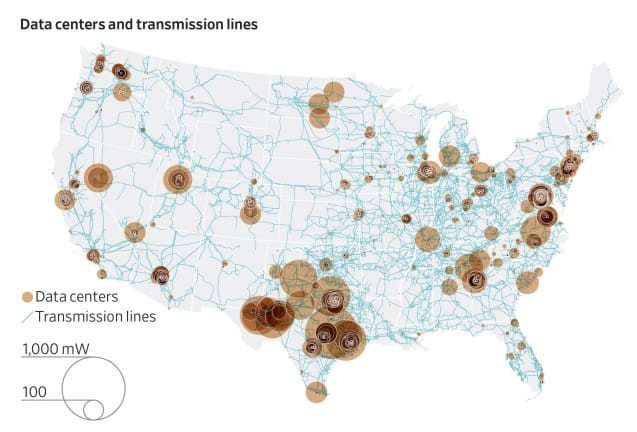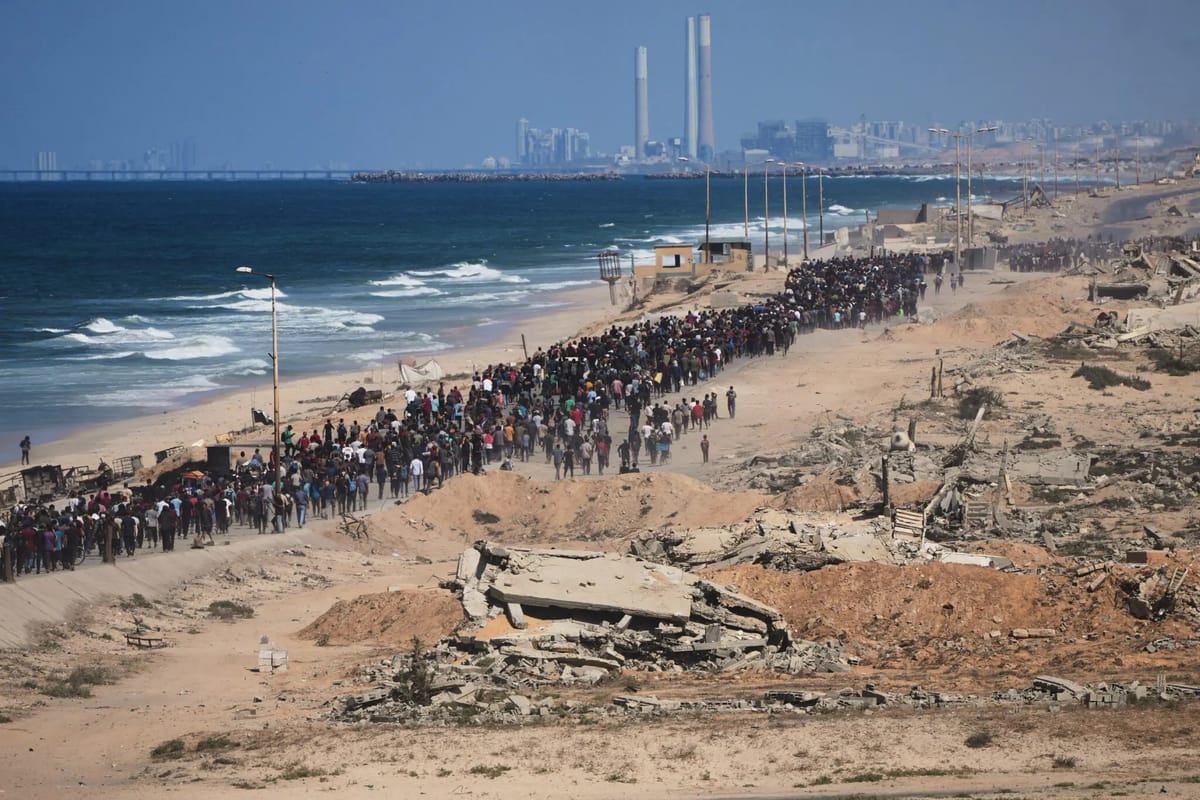Top 5 US news stories
October 16 2025

U.S. Power Grid Can't Keep Up With AI, Sparking 'Bring Your Own Power' Boom
U.S. Scrambles to Build Power for AI; China Adds Nearly 9x More Capacity
China Retaliates Against U.S. Chip Ban, Clamping Down on Critical Minerals
U.S. Escalates Pressure on Venezuela, Authorizing CIA Action Amid Military Buildup
Hamas Says It Can't Recover More Hostage Remains

1. U.S. Power Grid Can't Keep Up With AI, Sparking 'Bring Your Own Power' Boom
Tech companies in the AI race need power, and lots of it. They aren’t waiting around for the archaic U.S. power grid to catch up. In West Texas, natural-gas-fired power generation is under construction as part of the $500 billion Stargate project from OpenAI and Oracle . Gas turbines are in use at Colossus 1 and 2, the massive data centers Elon Musk’s xAI is building in Memphis, Tenn. More than a dozen Equinix data centers across the country are using fuel cells for power. With the push for AI dominance at warp speed, the “Bring Your Own Power” boom is a quick fix for the gridlock of trying to get on the grid. It’s driving an energy Wild West that is reshaping American power. Most tech titans would be happy to trade their DIY sourcing for the ability to plug into the electric grid. But supply-chain snarls and permitting challenges are complicating everything, and the U.S. isn’t building transmission infrastructure or power plants fast enough to meet the sudden surge in demand for electricity. America should be adding about 80 gigawatts of new power generation capacity a year to keep pace with AI as well as cloud computing, crypto, industrial demand and electrification trends, according to consulting and technology firm ICF. It’s currently building less than 65 gigawatts. That gap alone is enough electricity to power two Manhattans during the hottest parts of summer. Data centers have long taken power for granted, said KR Sridhar, founder and chief executive of Bloom Energy , which provides fuel cells to companies that need on-site power, often in a hurry. “You build the data center. Well, you just plug it in.” That isn’t possible anymore given the city-sized amounts of electricity needed to train AI models. One data center can devour as much electricity as 1,000 Walmart stores, and an AI search can use 10 times the amount of energy as a google search. The growth is intense, too. The U.S. had around 522 hyperscale data centers at the end of the second quarter, which account for around 55% of global capacity, according to Synergy Research Group. Another roughly 280 are expected to come online through 2028 in the U.S. Data centers consumed less than 2% of U.S. electricity before about 2020, but by 2028 could use as much as 12% of U.S. electricity, according to the Energy Department and Lawrence Berkeley National Lab. Utility executives compare the skyrocketing demand with rural electrification efforts or the advent of air conditioning, though much of that work happened in the years after World War II when American industry was roaring.

WSJ
2. U.S. Scrambles to Build Power for AI; China Adds Nearly 9x More Capacity
President Trump in January declared a national energy emergency, in part to keep the U.S. from falling behind China in the AI race. He has issued a series of related executive orders including one that aims to fast-track data-center construction and needed power infrastructure. The U.S. appears to have a lot of catching up to do. China will invest twice as much as the U.S. this year in power plants, storage and the grid, according to the International Energy Agency. It added about 429 gigawatts of new power generation last year, according to the think tank Climate Energy Finance, while the U.S. built about 50 gigawatts. The country has about four times the population of the U.S., but with centralized planning avoids many of the hangups in building everything from transmission lines to power plants. Most U.S. data-center developers cited grid access as their top concern. Project developers and utilities are trying to pick up the pace. ICF forecasts the U.S. will deliver almost 80 gigawatts of new generation starting in 2027, doubling the average pace of the past five years. Even so, in some locations, data centers won’t be able to plug into the power grid until the 2030s because of the sheer backlog of projects and the fact that the nation’s high-voltage electric wires are running out of room.

WSJ
3. China Retaliates Against U.S. Chip Ban, Clamping Down on Critical Minerals
Editors note: we previously reported on these rare earth export controls (story #4 10/10/25), but it was overshadowed by peace in the Mideast and bears repeating because it is the most important story in the world

Over the past three years, Washington has claimed broad power to impose global rules that bar companies anywhere in the world from sending cutting-edge computer chips or the tools needed to make them to China. American officials have argued that approach is necessary to make sure China does not gain the upper hand in the race for advanced artificial intelligence. But a sweeping set of restrictions announced by Beijing last week showed that two can play that game. The Chinese government flexed its own influence over worldwide supply chains when it announced new rules clamping down on the flow of critical minerals that are used in everything from computer chips to cars to missiles. The rules, which are set to take effect later this year, shocked foreign governments and businesses, which may now need to acquire licenses from Beijing to trade their products even outside China. With its dominance over the production of these rare earth minerals and its control of other strategic industries, China may have an even greater ability than the United States to weaponize supply chains, analysts say.

NYT
4. U.S. Escalates Pressure on Venezuela, Authorizing CIA Action Amid Military Buildup
The Trump administration has secretly authorized the C.I.A. to conduct covert action in Venezuela, according to U.S. officials, stepping up a campaign against Nicolás Maduro, the country’s authoritarian leader. The authorization is the latest step in the Trump administration’s intensifying pressure campaign against Venezuela. For weeks, the U.S. military has been targeting boats off the Venezuelan coast it says are transporting drugs, killing 27 people. American officials have been clear, privately, that the end goal is to drive Mr. Maduro from power. Any strikes on Venezuelan territory would be a significant escalation. After several of the boat strikes, the administration made the point that the operations had taken place in international waters. The new authority would allow the C.I.A. to carry out lethal operations in Venezuela and conduct a range of operations in the Caribbean. The agency would be able to take covert action against Mr. Maduro or his government either unilaterally or in conjunction with a larger military operation. It is not known whether the C.I.A. is planning any specific operations in Venezuela. But the development comes as the U.S. military is planning its own possible escalation, drawing up options for President Trump to consider, including strikes inside Venezuela. The scale of the military buildup in the region is substantial: There are currently 10,000 U.S. troops there, most of them at bases in Puerto Rico, but also a contingent of Marines on amphibious assault ships. In all, the Navy has eight surface warships and a submarine in the Caribbean.
NYT
5. Hamas Says It Can't Recover More Hostage Remains
Hamas’s military wing, the Qassam Brigades, said on Wednesday night that it had handed over all of the remains of Israeli hostages that it had been able to recover without additional equipment, potentially putting a cease-fire with Israel in the Gaza Strip at risk. In a statement, the Palestinian militant group said that it has “committed to what was agreed upon and handed over everyone it had in terms of living captives and what it had in terms of bodies that it could recover.” But it said that it needed “special equipment” to find and extract the remains of the rest of the deceased captives, adding that it was “making great efforts.” According to the terms of a cease-fire brokered by international mediators last week, Israel and Hamas would stop fighting and the militant group would return all the hostages it held — both living captives and the bodies of those who had died, totaling 48 people — in exchange for the freeing of Palestinians held by Israel, among other provisions. Hamas freed the 20 living hostages on Monday, and militants in Gaza had in the days since handed over the remains of eight people. Israel has identified six of those bodies as Israeli and one as Nepali. The identity of the eighth was not yet clear. The announcement that Hamas was unable to retrieve the remains of additional hostages came after the militant group handed over two more coffins to the Red Cross on Wednesday, putting the total number of bodies it has handed over at 10. That, however, left the remains of over a dozen people unaccounted for.
NYT
October 16 1934: The Long March begins
The embattled Chinese Communists break through Nationalist enemy lines and begin an epic flight from their encircled headquarters in southeast China. Known as Ch’ang Cheng—the “Long March”—the retreat lasted 368 days and covered 6,000 miles, more than twice the distance from New York to San Francisco.
Civil war in China between the Nationalists and the Communists broke out in 1927. In 1931, Communist leader Mao Zedong was elected chairman of the newly established Soviet Republic of China, based in Jiangxi province in the southeast. Between 1930 and 1934, the Nationalists under Chiang Kai-shek launched a series of five encirclement campaigns against the Soviet Republic. Under the leadership of Mao, the Communists employed guerrilla tactics to resist successfully the first four campaigns, but in the fifth, Chiang raised 700,000 troops and built fortifications around the Communist positions. Hundreds of thousands of peasants were killed or died of starvation in the siege, and Mao was removed as chairman by the Communist Central Committee. The new Communist leadership employed more conventional warfare tactics, and its Red Army was decimated.
With defeat imminent, the Communists decided to break out of the encirclement at its weakest points. The Long March began at 5:00 p.m. on October 16, 1934. Secrecy and rear-guard actions confused the Nationalists, and it was several weeks before they realized that the main body of the Red Army had fled. The retreating force initially consisted of 86,000 troops, 15,000 personnel, and 35 women. Weapons and supplies were borne on men’s backs or in horse-drawn carts, and the line of marchers stretched for 50 miles. The Communists generally marched at night, and when the enemy was not near, a long column of torches could be seen snaking over valleys and hills into the distance.
After enduring starvation, aerial bombardment, and almost daily skirmishes with Nationalist forces, Mao halted his columns at the foot of the Great Wall of China on October 20, 1935. Waiting for them were five machine-gun- and red-flag-bearing horsemen. “Welcome, Chairman Mao,” one said. “We represent the Provincial Soviet of Northern Shensi. We have been waiting for you anxiously. All that we have is at your disposal!” The Long March was over.
The Communist marchers crossed 24 rivers and 18 mountain ranges, mostly snow-capped. Only 4,000 troops completed the journey. The majority of those who did not perished. It was the longest continuous march in the history of warfare and marked the emergence of Mao Zedong as the undisputed leader of the Chinese Communists. Learning of the Communists’ heroism and determination in the Long March, thousands of young Chinese traveled to Shensi to enlist in Mao’s Red Army. After fighting the Japanese for a decade, the Chinese Civil War resumed in 1945. Four years later, the Nationalists were defeated, fled to what is today Taiwan, and Mao proclaimed the People’s Republic of China. He served as chairman until his death in 1976.
We are temporarily pausing our podcasts as we revamp our app so any article can be read as audio
Found a mistake? Have a news tip or feedback to share? Contact our newsroom using the button below:
citizen journal offers three flagship products: a daily national news summary, a daily Kansas news summary, and local news and school board summaries from 25 cities across 5 states. Use the links in the header to navigate to national, kansas, and local coverage. Subscribe to each, some, or all to get an email when new issues are published for FREE!
Brought to you by (click me!)





Sources
- https://www.wsj.com/business/energy-oil/ai-data-centers-desperate-for-electricity-are-building-their-own-power-plants-291f5c81?mod=hp_lead_pos7
- https://www.wsj.com/business/energy-oil/ai-data-centers-desperate-for-electricity-are-building-their-own-power-plants-291f5c81?mod=hp_lead_pos7
- https://www.nytimes.com/2025/10/16/business/economy/china-rare-earths-supply-chain.html
- https://www.nytimes.com/2025/10/15/us/politics/trump-covert-cia-action-venezuela.html?smid=nytcore-ios-share&referringSource=articleShare
- https://www.nytimes.com/2025/10/15/world/middleeast/hamas-gaza-hostages-remains-israel.html



